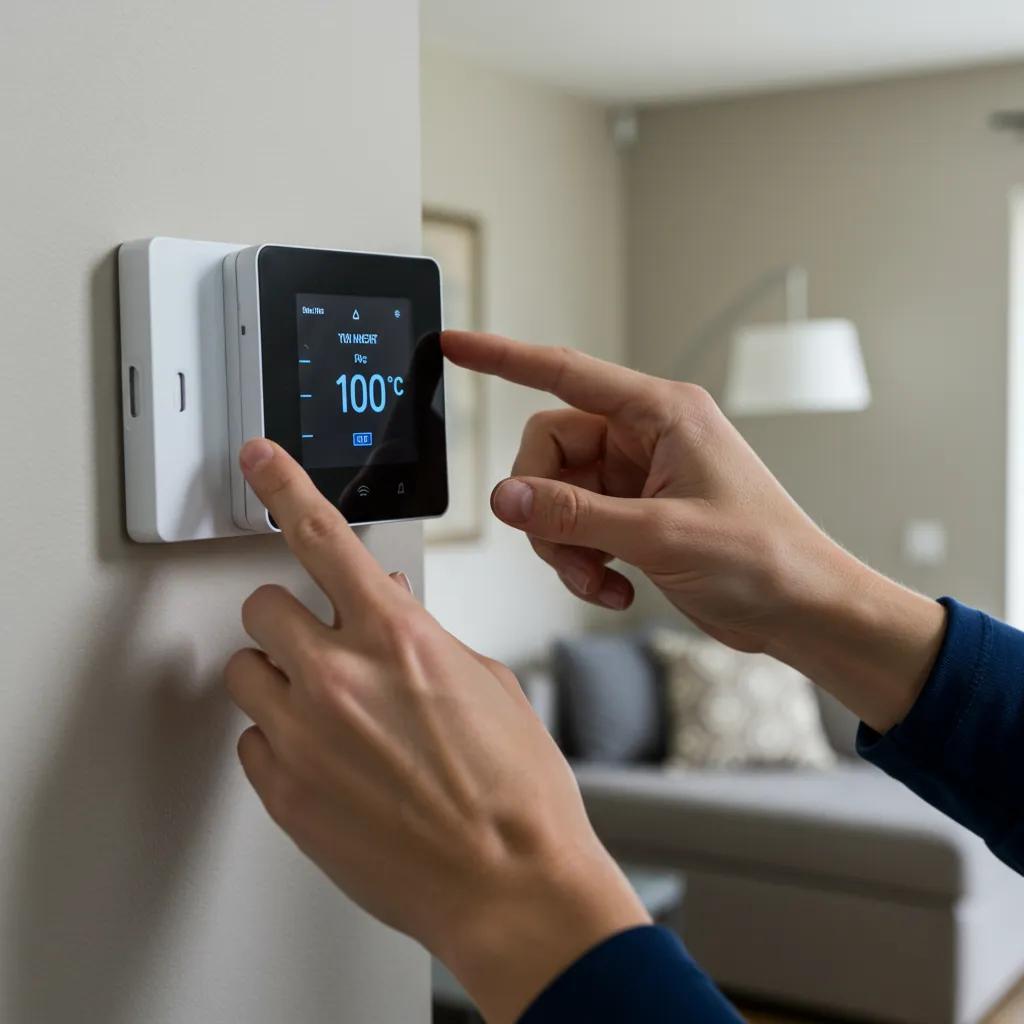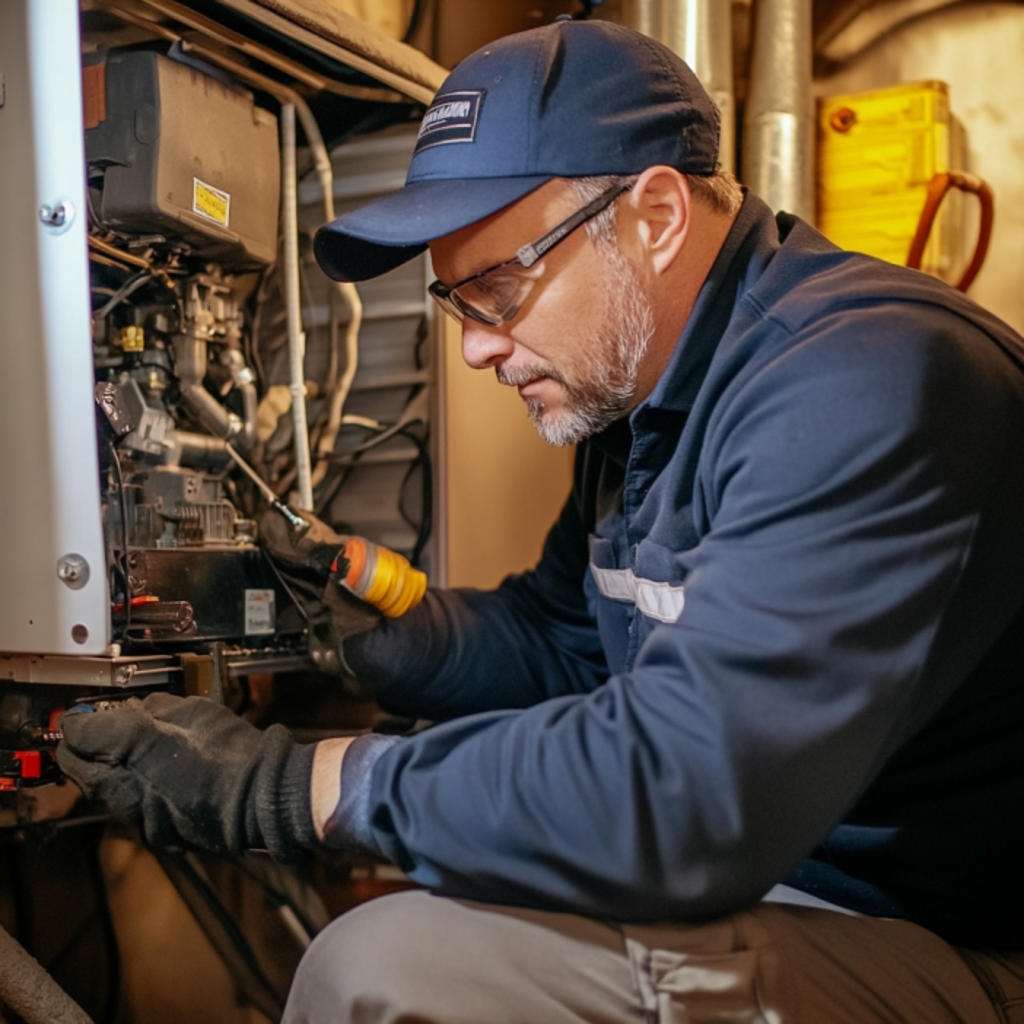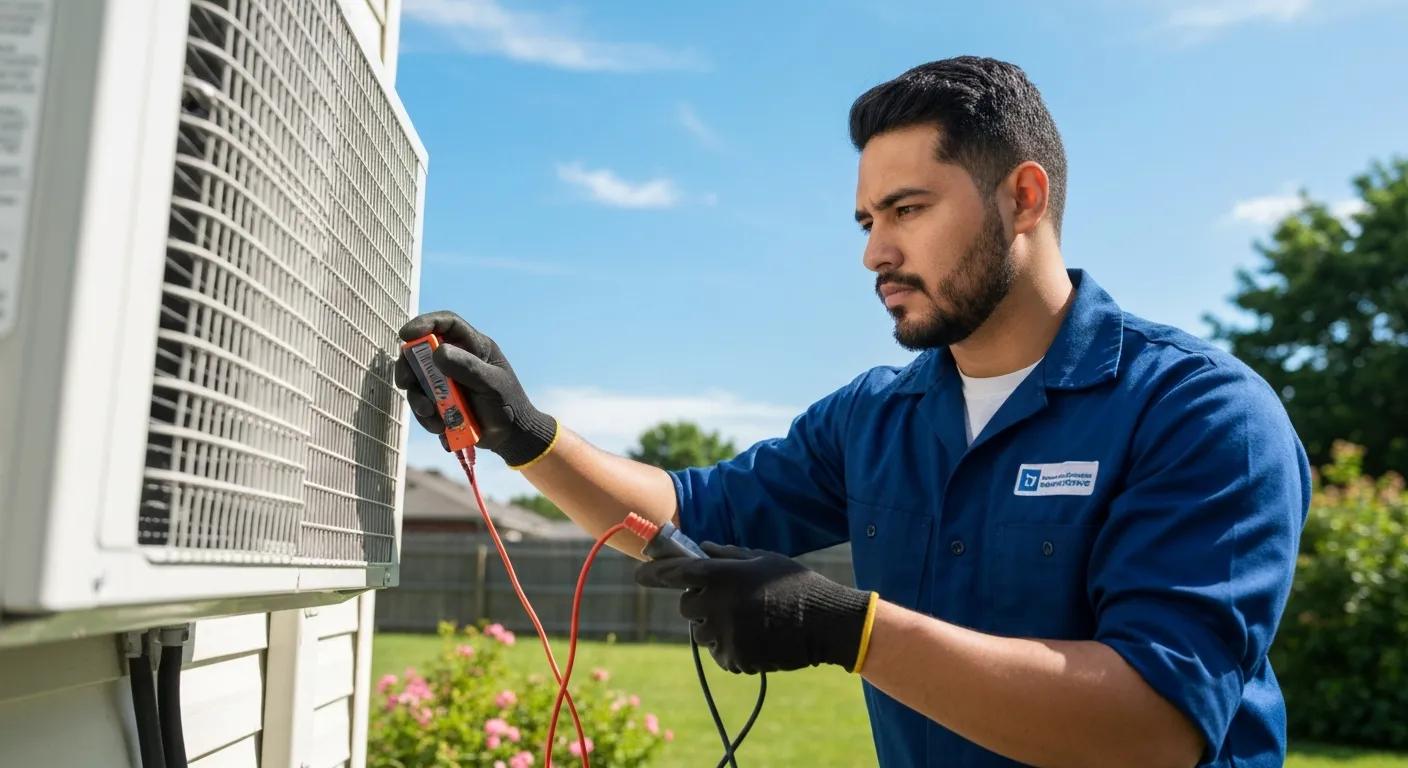Troubleshooting Common HVAC Problems: Expert Solutions for AC, Furnace, Heater, and System Issues
Is your home feeling uncomfortably warm even with the AC running, or is your furnace blowing chilly air when you crave cozy warmth? HVAC troubleshooting empowers homeowners and business owners throughout the Greater Killeen Area to pinpoint system faults, understand why they happen, and get your indoor comfort back on track efficiently. This in-depth guide will walk you through fixing an AC that isn’t cooling, a furnace blowing cold air, a heater that refuses to start, strange HVAC noises, water leaks, thermostat hiccups, and the essential maintenance steps to keep your systems running smoothly. Each section provides clear explanations, common causes, practical DIY tips, and guidance on when it’s time to call in the pros from The Coolest Air, so you can protect your investment and enjoy reliable temperature control all year long.
Why Is My AC Not Cooling? Common Causes and Quick Fixes
When your air conditioner isn’t cooling, it’s usually due to a disrupted refrigerant cycle, blocked airflow, or control system errors that prevent efficient heat transfer, leaving your home uncomfortable. Tackling AC troubleshooting right away can restore cool air, boost energy efficiency, and extend your equipment’s lifespan. Figuring out the core issue first helps determine if it’s a simple fix or a job for a professional.
What Are the Main Reasons for AC Blowing Warm Air?
Here’s a look at the key components that typically cause your AC to blow warm air when something goes wrong:
| Component | Fault Type | Impact on Cooling |
|---|---|---|
| Refrigerant Line | Leak or low charge | Hinders heat absorption |
| Air Filter | Clogged with debris | Restricts airflow and coil performance |
| Compressor | Mechanical failure | Halts refrigerant circulation |
| Thermostat | Incorrect calibration | Sends inaccurate cooling signals |
Identifying the faulty part helps streamline repair plans and clarifies whether a simple DIY filter change or a professional compressor check is needed.
How Can I Diagnose and Fix an AC That Won’t Turn On?
Start by making sure your outdoor unit and indoor controls are receiving power, then follow these steps to address common startup problems:
- Double-check that your circuit breakers are in the ON position and reset any that have tripped.
- Inspect your thermostat’s batteries or wiring to confirm it’s getting proper voltage and sending signals.
- Examine the condensate safety switch for any blockages or leaks that might be shutting down the unit.
- Clear dirt and debris from your condenser coil fins to prevent the system from overheating.
- Listen for a humming sound from the relay; if you don’t hear a click when calling for cooling, the contactor might need replacing.
Following these steps often gets your system running again. If the issues persist, it’s likely time for specialized diagnostic tools.
What Should I Do If My AC Is Leaking Water?
Water leaks typically happen when the condensate drain line gets clogged or when the evaporator coils freeze over and then thaw rapidly, causing excess moisture to spill. Clearing out the condensate drain line using a wet-dry vacuum or a flexible brush can remove blockages and prevent overflows. Also, ensure the drain pan is level and in good condition to avoid standing water. Proper drain maintenance protects your ceilings, carpets, and walls from water damage and mold.
How to Identify and Resolve Strange Noises from Your AC Unit?
Rattling, hissing, or grinding sounds are red flags indicating mechanical stress in fans, compressors, or refrigerant lines, pointing to wear or blockages. Listen carefully to pinpoint the source of the noise—loose panel screws might cause rattles, refrigerant leaks can produce hissing, and motor bearings often emit grinding sounds. Tighten any accessible panels, lubricate fan bearings with the correct oil, and schedule a refrigerant leak repair if the hissing continues. Addressing these symptoms early can prevent component failure and costly breakdowns.
When Should I Call a Professional for AC Repair in Killeen?
Reach out to The Coolest Air if you’re dealing with refrigerant leaks, compressor failure, persistent electrical problems, or safety switch trips after trying basic DIY fixes. Professional diagnosis is crucial for sealed-system repairs, high-voltage components, and handling refrigerants. Bringing in certified HVAC technicians ensures repairs are done correctly, restores optimal cooling, and keeps your equipment warranty valid.
How to Fix a Furnace Blowing Cold Air: Troubleshooting and Solutions

When your furnace blows cold air, it usually points to ignition problems, airflow imbalances, or control board malfunctions that stop heat production and distribution. Prompt furnace troubleshooting can restore warm airflow, cut down on wasted energy, and ensure your home stays warm.
What Causes a Furnace to Blow Cold Air Instead of Heat?
Here are the common furnace components and their failure modes that lead to cold air:
- Pilot Light or Ignitor Malfunction – If there’s no spark or flame, the burner can’t heat the heat exchanger.
- Dirty Flame Sensor – Buildup on the sensor can interrupt the ignition confirmation process.
- Airflow Obstruction – Clogged filters or closed dampers restrict heat transfer and can trigger safety shutdowns.
- Control Board Faults – Defective relays or incorrect thermostat signals can prevent the burner from activating.
Understanding these potential issues helps focus your efforts on ignition systems, filter maintenance, and control diagnostics.
How Do I Troubleshoot a Furnace That Won’t Ignite?
Follow these steps to get your furnace to ignite:
- Turn off the power, then check the burner assembly for any debris and clean it if necessary.
- Reset your furnace by turning the thermostat to OFF, waiting five minutes, and then switching it back to HEAT.
- Inspect the flame sensor for corrosion; gently sand the rod to improve its conductivity.
- Use a multimeter to test the limit switch and rollout switch for continuity.
- Listen for a click from the gas valve when the thermostat calls for heat to verify it’s operating.
These steps often resolve ignition failures. If the problem continues, professional flame-safeguard service is likely needed.
What Are the Signs of a Faulty Furnace Blower Motor?
A failing blower motor can result in weak airflow, loud squealing noises, or intermittent operation due to worn bearings or electrical issues. Check the motor capacitor for any bulging or leakage, and test it with a capacitance meter. Clean the blower wheel blades to restore balance, and lubricate the shaft bearings if they are accessible. Replacing a worn motor or capacitor will restore consistent heat distribution and prevent overcurrent shutdowns.
When Is It Time to Contact HVAC Experts for Furnace Repair?
Call for professional service if gas valve adjustments, flame sensor cleaning, or limit switch replacements don’t bring back warm air. Certified technicians can safely handle gas connections, combustion analysis, and high-voltage components. Prompt furnace service from The Coolest Air ensures your heating remains reliable and protects against carbon monoxide risks.
Heater Not Turning On? Step-by-Step Troubleshooting and Repair Tips
Troubleshooting your heater involves checking power supply issues, thermostat controls, and safety interlocks to restore reliable warmth and ensure system safety.
What Are the Common Reasons a Heater Fails to Start?
Heater startup problems usually stem from:
- Thermostat Malfunction – Incorrect signals can prevent the system from initiating a heat cycle.
- Tripped Safeties – High-limit or flame rollout switches might open to protect the equipment.
- Power Disruption – Blown fuses or tripped breakers can cut off electrical flow.
- Clogged Filters – Restricted airflow can trigger safety shutoffs.
Recognizing these causes helps focus your troubleshooting on controls, power circuits, and airflow.
How to Check Thermostat and Power Supply for Heater Issues?
First, confirm that your thermostat display is powered on and set to the heat mode. Replace the batteries and recalibrate if the displayed temperature doesn’t match the room’s actual temperature. Next, check your circuit breaker panel for any tripped heater circuits and reset them. Use a non-contact voltage tester to check the voltage at the furnace’s junction box. Fixing control or power issues often gets your heater working again without further steps.
How Can I Safely Reset or Repair My Heater?
To reset a furnace or electric heater, turn the unit off at the thermostat, wait five minutes, and then switch it back to the HEAT setting. For electric heaters, unplug the unit, inspect the power cord and plug for damage, and check for an internal reset button. Replace any damaged wiring or blown fuses according to the manufacturer’s instructions. Simple resets and minor repairs can resolve many startup issues, but complex heating repair problems require professional expertise.
When Should You Schedule Professional Heater Service?
Schedule professional heater service if reset procedures don’t work, safety switches keep tripping, or you notice unusual odors when the unit starts up. The Coolest Air’s certified technicians perform thorough safety inspections, heat exchanger tests, and detailed electrical diagnostics to ensure your system operates reliably and safely.
How to Diagnose and Fix Strange Noises in Your HVAC System
Troubleshooting HVAC noises can prevent minor rattles from turning into major mechanical failures, protecting your equipment and maintaining a peaceful indoor environment. AC maintenance can help ensure everything is functioning smoothly.
What Types of Noises Indicate Serious HVAC Problems?
- Hissing often signals refrigerant leaks or pressure issues.
- Grinding usually points to worn motor bearings in fans or blowers.
- Banging can be caused by ductwork expansion or loose internal components.
- Clicking might indicate relay activity or ignition attempts.
Recognizing these sound patterns allows for targeted troubleshooting and helps preserve your equipment’s integrity.
How to Identify Noises from the AC Compressor, Furnace, or Fan?
Pay attention to where the noise is coming from—compressors make humming sounds from outdoor units, furnaces can clatter in the main air handler, and fans might whine from within the system. Use a mechanic’s stethoscope to pinpoint the exact source. Tighten loose fasteners on ducts, replace worn fan belts, and secure mountings to reduce vibrations. Identifying the component responsible guides the appropriate repair.
What Are Simple DIY Fixes for Common HVAC Noises?
Before calling a professional, try these fixes for common HVAC noises:
- Tighten any loose screws on access panels and duct connections.
- Lubricate fan and blower bearings with oil recommended by the manufacturer.
- Replace old fan belts and check that the pulleys are aligned correctly.
- Clean the condenser and evaporator coils to reduce airflow turbulence.
These simple steps can often silence minor noises and extend the life of your components.
When Is Professional Noise Diagnosis Necessary?
Seek expert service if grinding noises persist after lubrication, hissing sounds continue even after changing filters, or banging suggests internal debris. Professional technicians from The Coolest Air have specialized tools to detect refrigerant leaks, balance rotating parts, and safely replace high-precision components.
What to Do When Your AC Is Leaking Water: Causes and Repairs
Condensate leaks in air conditioning systems are usually caused by clogged drain lines, improperly aligned condensate pans, or frozen coils that thaw too quickly. Addressing these issues prevents water damage and mold growth while ensuring your cooling system works without interruption.
Why Does My AC Leak Water Inside or Outside the House?
Leaks inside your home often result from blocked condensate drains or overflowing pans, while leaks outside might indicate a cracked pan or misaligned drain lines. Insufficient insulation on refrigerant lines can also lead to coil freezing and subsequent overflow when the ice melts. Pinpointing the leak’s origin helps guide the necessary cleaning, realignment, or insulation repair.
How to Clear a Clogged Condensate Drain Line?
Start by removing the access cap on the drain line and using a wet-dry vacuum to clear out any blockage. Flush the line with a mixture of warm water and mild soap, or use a manufacturer-approved condensate cleaner. Finally, replace the cap and test the drainage by running your AC for a few minutes. Clearing the line promptly restores proper condensate flow and prevents overflows.
What Maintenance Prevents AC Water Leaks?
Regularly replacing filters, cleaning coils twice a year, and inspecting the condensate line annually helps keep drainage systems clear. Ensuring that pan and line connections are secure and leak-free also prevents moisture buildup. Consistent maintenance reduces the risk of water damage and extends your equipment’s lifespan.
When to Call The Coolest Air for AC Leak Repairs?
If water leaks continue after you’ve cleared the drain line, or if you notice corrosion on the pans and pipes, contact The Coolest Air for a professional evaluation of your condensate system. Expert leak detection and repair by certified technicians will protect your home from moisture damage.
How to Troubleshoot Thermostat Issues Affecting Your HVAC System

Troubleshooting your thermostat ensures accurate temperature control, efficient system operation, and consistent comfort in your home.
Why Is My Thermostat Not Responding or Showing Incorrect Temperatures?
Thermostat problems are often caused by low batteries, loose wiring, sensor inaccuracies, or software glitches in smart models. A thermostat that isn’t responding correctly can send false signals to your HVAC system, leading to improper heating or cooling cycles. Identifying these issues restores accurate temperature management and comfort.
How to Reset or Replace a Smart or Programmable Thermostat?
To reset, remove the thermostat from its base for about a minute before putting it back; this can clear temporary software errors. If you need to replace it, first turn off the power at the breaker, label the existing wires, install the new device following the instructions, and then restore power. A proper reset or replacement ensures correct communication with your HVAC components and reliable control.
How Does Thermostat Wiring Affect HVAC Performance?
Incorrect or corroded wiring connected to the R, W, Y, G, and C terminals can send faulty signals, preventing your system from calling for heat or cool. Verifying that all wire connections are secure, cleaning off any oxidation, and correctly labeling each wire ensures precise command execution. Proper wiring alignment directly impacts heating installation efficiently your system cycles and responds.
When Should a Professional Inspect Your Thermostat?
Schedule a professional inspection if reset procedures don’t resolve the issue, wiring problems persist, or your smart thermostat displays repeated error codes. The Coolest Air’s technicians can perform advanced diagnostics, update firmware, and handle complex wiring repairs to get your HVAC system running smoothly again.
What Preventative Maintenance Can Avoid Common HVAC Problems?
Regular HVAC maintenance helps improve system efficiency, extends equipment life, and prevents costly breakdowns by addressing potential issues before they become major problems. Seasonal maintenance is essential for optimal performance.
How Often Should You Replace HVAC Filters and Why?
Swap out standard filters every 1–3 months, and higher-efficiency MERV filters every 6 months, to keep airflow unrestricted and protect your coils from dust buildup. Clean filters contribute to better air quality, lower energy use, and prevent strain on your heat exchanger or evaporator coils.
What Are Key Annual HVAC Tune-Up Tasks?
An annual tune-up should include checking the refrigerant charge, cleaning the coils, inspecting the blower assembly, tightening electrical connections, testing safety controls, and lubricating moving parts. These thorough checks ensure efficient heat transfer, stable airflow, and reliable component operation.
How Does Regular Maintenance Improve Energy Efficiency?
Consistent upkeep prevents heat-exchange surfaces from getting dirty, stops motors from being overloaded, and avoids refrigerant undercharging—all factors that increase energy consumption. Well-maintained systems can operate up to 15 percent more efficiently, leading to lower utility bills and less wear on your equipment.
When to Schedule Preventative Service with The Coolest Air?
For your peace of mind and to ensure optimal performance, schedule seasonal inspections and tune-ups with The Coolest Air. Professional maintenance helps maintain your warranty, catches potential issues early, and ensures your HVAC system provides reliable comfort all year long.





